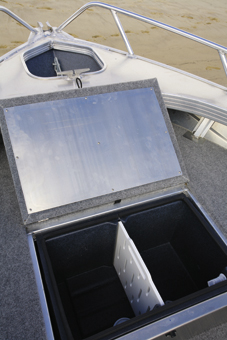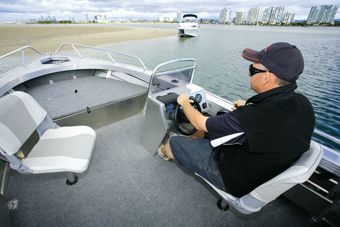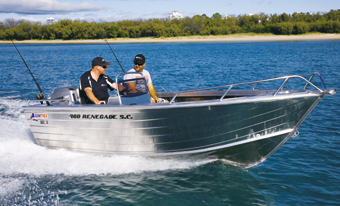QUINTREX RENEGADE 4.6
- NAFA
- Feb 1, 2012
- 4 min read
The Quintrex Renegade 4.6 is a highly-affordable fishing boat for any situation involving some open water, due primarily to its high-sides and full-height engine-well; and it handles choppy water noticeably better than your average tinny.
The unpainted 4.6 metre Quintrex Renegade side-console seen here was actually tested for sister mag Barra Bass and Bream and I thought it “pretty good news for fishers looking for a boat to fish open estuaries, big lakes and anywhere else where you require a run across open water.” For NAFA readers, this translates to a great fishing boat for any situation involving some open water — which applies virtually right around the country. Whilst hardly an “offshore fishing boat,” the Renegade’s high-sides and full-height engine-well make for a level of fundamental safety rarely found in boats this size.
Renegade is something of a departure for Quintrex, which usually focuses on upmarket boats with leading-edge hull designs and tricked-out interiors.
It sits somewhere short of that as a fairly complete package deal at a highly-attractive price. Think boat/motor/trailer prices around $20/22,000 for a boat like the one you see here, unpainted and powered by a 50hp carburettor 2 stroke, with a flat uncluttered deck in an aft full-depth “cockpit” that steps up forward of the passenger seating to become a bow casting deck with stowage underneath. Yup; precisely the kind of boat lots and lots of us fish from, people who probably wouldn’t have considered a Quintrex because their sophisticated hulls and upmarket fit-outs make them too expensive...
The options list is deliberately short, but the package deal includes the console and steering, two pedestal seats, side decks, a full height engine-well, an anchor-well on the foredeck, rails, transducer bracketing and a transom step. Quintrex’s intent is a (more or less) ready to go fishing package needing little more investment and it appears to me it’s scored a bulls-eye on this one.
The options list includes paintwork (something a lot of keen fishos prefer to do without) a 70L under-floor fuel tank (well worth the extra investment), hydraulic steering, a bimini shade top, a live-bait tank aft, a live-well under the bow deck and a colour fish finder (which few people would do without these days, although many would prefer to make their own choice.)
There are actually two Renegade packages: the 4.6m side-console seen here, and a 5.2m centre-console which would of course extend open-water possibilities while not being quite as useable in the tight confines of a mangrove creek or whatever... The 5.2 with a 75hp 2-stroke starts out around $25,500.
One of the first things Quintrexphiles will notice about both Renegade models is that Quinnie’s characteristic flared bows aren’t there. In return for their absence though, you do get a stretch-formed variable deadrise hull-bottom which achieves two things.
Firstly, out on the water, the Renegade hull handles choppy water noticeably better than your average tinny — if not as well as Quintrex’s (more expensive) Millennium models. Nonetheless, better than your average tinny it definitely is, thanks obviously to the stretch forming providing a steeper deadrise in that critical area where the bows penetrate surface chop. Like similar Stacer hulls from the production line next door, the Renegade tracks like an arrow and exhibits a fine set of manners indeed when you put it into the kind tight turns the cramped waterways of the Gold Coast, for example, dictate.
Secondly, the loss of Quintrex’s characteristic flared bows pays a dividend when it gains fishing room on the bow casting deck where the fuller angles provide noticeably more deck space than Millennium hulls where the flare pinches in. In terms of its hull design, the Renagade is a clear win-win.
I also thought the Renegade 4.6 was a little more stable underfoot when up on the bow-deck fishing. Being something of a lightweight though, perhaps final judgment should be left to folk who present more of a challenge here.
Fishing in the aft section of the boat finds good support for your legs from the side decks although the side pockets do compromise this some. Me? I’d ask whether they can be omitted during build, even just the portside one which is the most intrusive. It’d be the perfect location for a simple rod rack!
Four plastic rod holders in the side decks comprise rod stowage in its entirety. I guess horizontal rod stowage along the portside is too much to hope for in a value for money package...
Performance-wise, the 50hp 2-stroke-powered test boat didn’t quite achieve 50km/hr, but had generous torque available lower down the rev range. The hull is rated to 60hp and in fact I’ve also tested a 4.6 Renegade running a 60hp Mercury 4-stroke. As you’d expect, the 4-stroke was a lot more civilised (and quieter) motor at low revs. However, I couldn’t perceive any real difference at cruising revs or higher, and it had a slightly higher top speed, again, as you’d expect.
This boat is a classic case where choosing a carb 2-stroke and investing the dollars left in the budget afterwards in an electric or better electronics may be the smart option. If an upgrade to a 60hp 2-stroke, or indeed a 4-stroke, is affordable, I doubt you’d be disappointed.
I think Quintrex is on a winner with its new Renegade models. In the value for money and performance for dollar stakes, they’re very attractive packages indeed! www.quintrex.com.au SPECIFICATIONS Length 4.60m Beam 2.09m Bottom 3.0mm Sides 2.00mm Transom 3.0mm Hull Weight approx 338kg Max Engine Weight 120kg Max HP 60hp Recommended HP 50-60 hp Fuel Tank 70L (optional)








